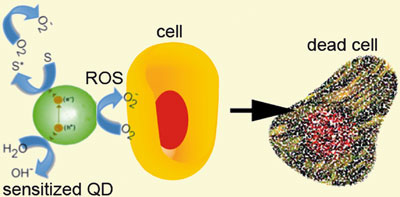| Posted: October 1, 2009 |
Researchers suggest quantum dots as a potential skin cancer treatment |
|
(Nanowerk News) Resolving questions surrounding nanoparticle toxicity has led North American researchers to suggest the particles as a potential skin cancer treatment ("Photosensitization of CdSe/ZnS QDs and reliability of assays for reactive oxygen species production" – free access paper).
|
 |
| Dopamine-conjugated quantum dots release cytotoxic reactive oxygen species when treated with light
|
|
Jay Nadeau from McGill University, Montreal, and colleagues in the US and Canada are investigating using semiconductor nanoparticles, called quantum dots, as photosensitisers - compounds that release reactive oxygen species, such as singlet oxygen, when exposed to light. Photosensitisers can be used in photodynamic therapy, which applies the reactive oxygen species to kill cancer cells. Nadeau's team has measured the reactive oxygen species produced by quantum dots and observed their subsequent effects on mammalian cells using a series of assays.
|
|
Currently there is a lot of controversy whether quantum dots do produce reactive oxygen species, and if so which ones. Nadeau says she believes her team has finally been able to resolve the issue by standardising experiments. 'Figuring out which assays are best to use will allow you to screen compounds in a way that is valid, so will allow different groups to at least coordinate their results,' she says.
|
|
"Similar conjugated nanoparticles could potentially be used in photodynamic therapy for skin cancer treatment."
According to Nadeau 'some nanoparticles don't make singlet oxygen but they do when they are connected to small molecules like [the neurotransmitter] dopamine. That opens up a whole other avenue for investigation,' she says. Her team also found that the dopamine-conjugated quantum dots can be used to kill mammalian cells but only on irradiation with UV-to-blue light. This means the quantum dots are unlikely to be toxic in the body, where the light cannot penetrate, but could have an effect on skin, the researchers claim. They suggest that similar conjugated nanoparticles could potentially be used in photodynamic therapy for skin cancer treatment.
|
|
|
|
Juan Mareque-Rivas, an expert in fluorescent nanoparticles, from the University of Edinburgh, UK, says 'this is a long overdue investigation. It is nice to see a study in which generation of different reactive oxygen species is demonstrated, quantified and rationalised, and linked to interactions with dopamine - it warns that biomolecules can enhance the phototoxicity of quantum dots.'
|
|
Nadeau's team next plans to move the project into an in vivo melanoma model, to see if dopamine-conjugated quantum dots collect in tumours. Further plans include using quantum dots to develop a cream for healing surgical wounds as well as in water decontamination.
|

